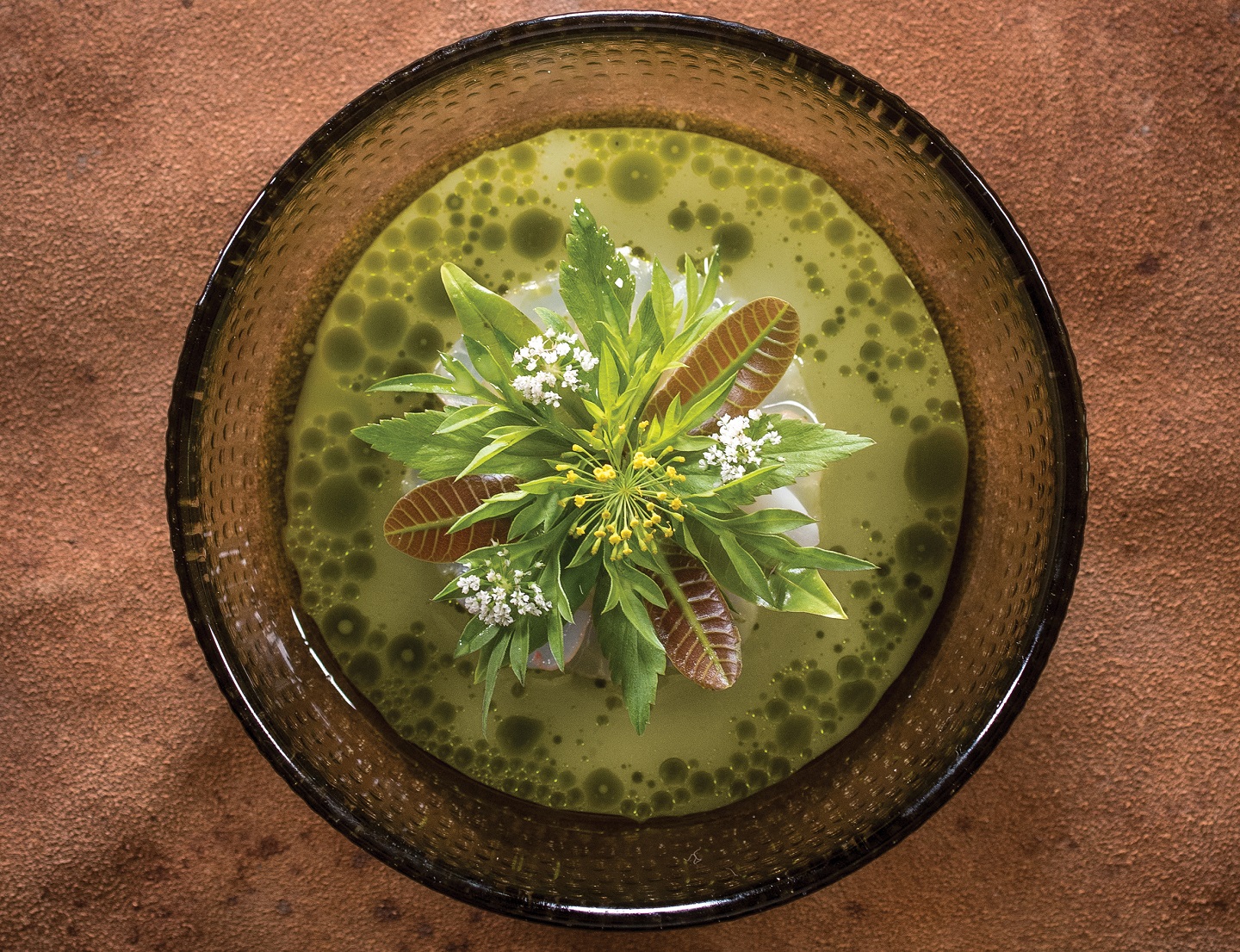
Dewakan's Prawns warmed in starfruit juice with herbs (Photo: Dewakan)
There is a world of familiarity contained in the pieces of choy sum “nori” — propped up by twigs on a wooden board — that greets you when you sit down to dine at Dewakan. The sturdy vegetable, usually stir-fried, dressed with a slick of oyster sauce or glitzed up with braised meat at Chinese New Year dinners, has turned over a new leaf as an amuse bouche at Dewakan. The satisfying crunch of the choy sum cracker, accompanied by an aioli dip made from fermented fish sauce, yields an instantaneous feeling of wonder, an effect that also describes the food of owner and chef Darren Teoh.
Dewakan, situated in the depths of Glenmarie, Shah Alam, is lauded at home and abroad as a reflection of Teoh’s growing understanding of and accelerating creativity in modern Malaysian cuisine. Armed with a simple appetite yet scholarly zeal, Teoh has presented indigenous ingredients in their most delicious and sometimes wacky forms to help diners appreciate the minutiae and potential of each individual produce. That being said, Teoh has never quite thought of himself as an advocate for local ingredients; he just regarded them as what they should and could be.
Teoh has crafted dishes that invoke all the senses, including the sense of disbelief. At times, his food takes us past our comfort zone without inflicting anything too bizarre. For his new menu at Dewakan, the flavours sparkle, and the colours on the plate glow even more, like the visually arresting sweet leaf sorbet and nam nam, a bitter fruit that tastes like pear with skin that resembles that of a toad, hence its other name buah katak puru. The disparate taste between the two ingredients consummated in a refreshing dessert sans the earthy vegetable twang. A brittle piece of dehydrated milk dusted with roselle powder lends the dish texture and an unexpected modern personality.
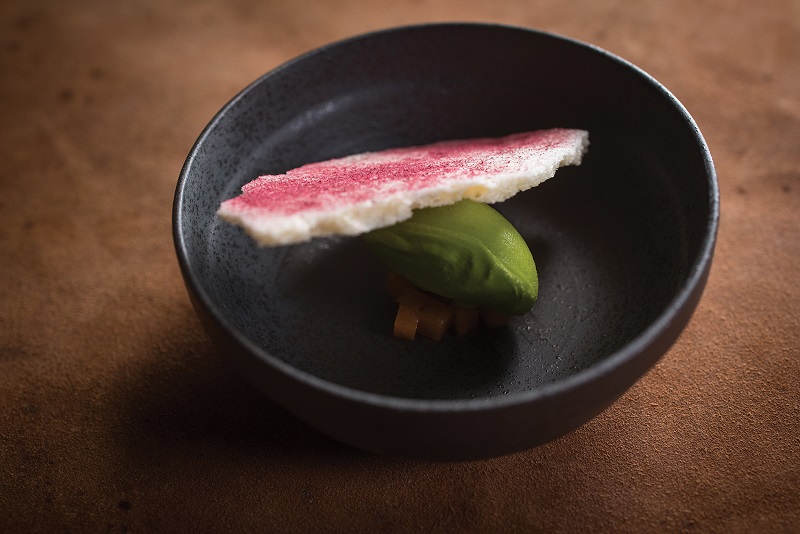
The discord on the plate goes to show how Teoh disregards familiar contexts or common cooking methods in an effort to form new ones. The clever interplay between ingredients, both novel and authentic, engenders a stream of surprises that never lets up. At Dewakan, dishes are contemporary without being alarming because these are ingredients you already know, but just not used in their traditional manner. Case in point: the tender shoots of sweet leaf or sayur manis in your regular pan mee noodle soup.
Dewakan stands out as one of a handful of restaurants in the city that builds its menu around locally sourced ingredients, where its food speaks to imagination and a reverence for our local bounty. In a province with so much to offer, and restaurants mining the concept of eating locally because diners now care more than ever about where their food originates from, you would think that eateries would take advantage of the food growing in their own backyard. Alas, creating haute locavore cuisine still has its challenges.
“Not all produce in our country is at the quality it has the potential to be. There is a huge variety of ingredients that are excellent to use. But looking at it holistically, there are production and distribution aspects that should be improved on, from best practices of farming and the way these ingredients are distributed to the end user, to the way they are stored before sales. These ingredients are often mistreated or not cared for enough to maintain their quality before they reach restaurants or even markets. There are well-meaning farmers who greatly respect their produce but it’s difficult to bridge the gap with the end users. Logistics and pricing are large hindrances,” Teoh laments.
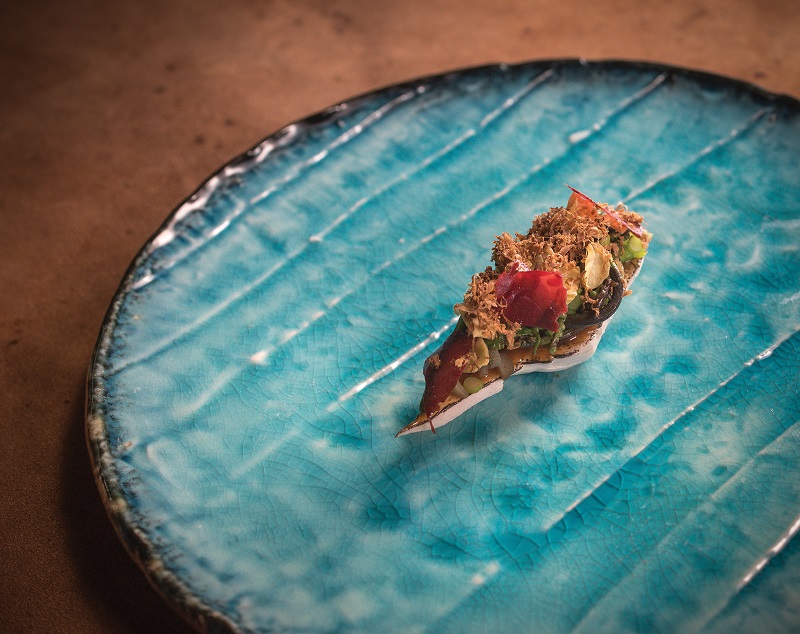
Our land is blessed with an agricultural cornucopia of unparalleled variety, from buah kulim — little brown spheres that possess an explosively piquant garlic flavour — used by the Semai community to cook curries and petai belalang with a faint petai scent that is rich in amino acid, to pucuk gajus that is known to reduce blood sugar levels and blood pressure. But tracing these ingredients and our regional foodways is a gruelling undertaking due to the sheer lack of information or education.
Teoh, however, believes there is still a cadre of thoughtful chefs and researchers in the country who scour our flora and fauna to reignite forgotten food traditions. “A former colleague of mine moved to Malaysia in the 1980s and worked as a chef in a rather prestigious hotel in Kuching. He was intrigued and impressed with the local eating culture, so he regularly sent his chefs to source from the local people and markets for wild produce from the Bornean jungles.
“Eric Olmedo, the principal research fellow for the Institute of Ethnic Studies at Universiti Kebangsaan Malaysia, is documenting the various Peranakan cultures of the country, including the Chitty Peranakans in Melaka. In Penang, private dining by Baba Jerry, Nyonya Su Pei and Nyonya Chin See guide willing participants through original Straits Chinese cooking and culture,” he says.
“[Sourcing for local ingredients] may sometimes take a back seat … but there is still some excitement in using the ingredients we grew up eating. Chefs like Marcus Low (Table & Apron), Jeff Ramsey (Babe), Christian Recomio (Sitka Studio), Raymond Tham (Beta KL) as well as Johnson Ebenezer, Sricharan Venkatesh and Akshar Chalwadi from Nadodi, all take their cues from the land they cook in. You will find nuances of Malaysian backyard ingredients in their cooking.”

More homegrown chefs are paying tribute to our local terroir in their restaurants, where wild ingredients do not just make an occasional appearance but are given top billing. Restaurant owners are fanning out across the country to gather edible wild plants as foraging — which is not new to us, and is a cherished tradition in, say, Nordic countries where extreme poverty in the late 19th century helped birth a nation of thrifty foragers — has entered our dining lexicon and gained momentum. To locate these native plants — such as petai belalang, which is found in our residential areas or next to the highway — is a pleasant bonus, but to turn them into a starring, tasty dish is a skill.
While foraging reacquaints us with our land and roots, Teoh finds that the concept has been loosely thrown around in recent years. “It has become the romanticised buzzword of the culinary world. I’m not saying it’s a bad word. It needs to be used in the right context. Do you pluck from the rambutan tree or do you forage from it? I think the activity is a very personal one. The experience of eating rambutan you obtained yourself versus [the one you buy] in bundles and sold faceless on a table in some night market. Both are yielded by the same process but with very distinct experiences.”
There is also the problem of commercialising what the earth is dishing up for free. Exploiting a pursuit that only used to be about scurrying in the woods for hidden gems could take a toll on the ecosystem. Reaping the rewards of the land must be done sustainably, a notion that Beta KL head chef Raymond Tham, who includes at least 80% local ingredients, such as the rare belimbing buluh and pucuk petai in the restaurant’s menu, steadfastly upholds.
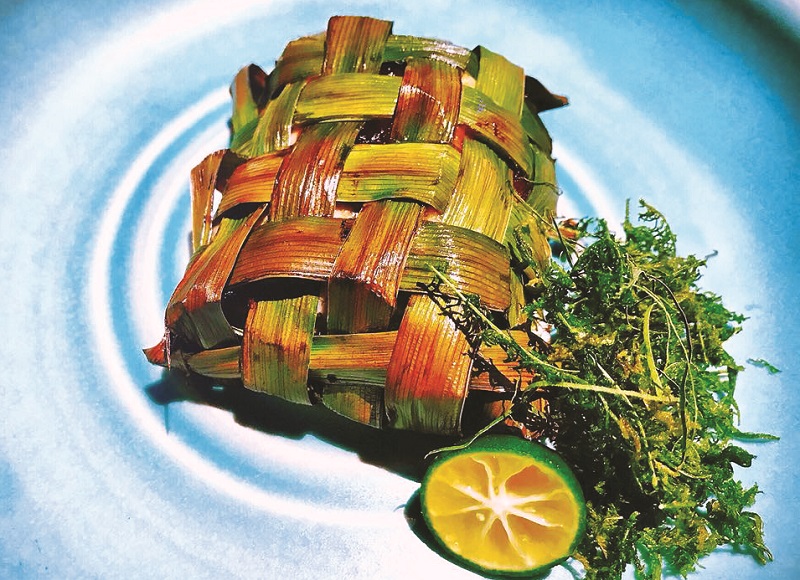
“I recently took a trip to Cameron Highlands and found an unfamiliar produce called litsea cubeba or ‘Mountain Pepper’ (shān hújiāo in Mandarin), which produces a citrusy essential oil from its fruit and leaves. The Orang Asli use it to cook with fish. Foraging helps us develop a relationship with the community. As chefs, we need to keep ourselves informed of not just where but also how we source our produce. At Beta KL, our ingredients are sourced directly from small-time suppliers, wet markets and local farmers around Malaysia.”
Restaurants may be re-educating our palates by imparting the importance of sustainability and impact of “food miles” — the long distances most food is shipped before arriving at our local supermarket and, ultimately, on our plate — but diners must have a receptive ear and an appetite for awareness.
“We have to consider the biggest part of the equation — the clients. Does the Malaysian market see the value of paying for locally grown, harvested or foraged items? Or are they looking for value in strictly imported ingredients?” says Teoh.
There is also the problem of commercialising what the earth is dishing up for free. Exploiting a pursuit that only used to be about scurrying in the woods for hidden gems could take a toll on the ecosystem
Tham shares the same sentiment. “We always have this mindset that anything imported is good. Because of that, there’s not much demand for local produce and many suppliers don’t supply them. I was surprised that fresh culinary graduates are not well-versed with local ingredients such as ulam … Exposure and education are crucial as there are many underrated ingredients [that are waiting to be discovered]. My recent trip to the Sibu market was an eye-opener. I like the paku midin, a Sarawakian vegetable similar to paku pakis that maintains a crisp texture even after stir-frying it with belacan.”
Numerous restaurants around the world have dug into the roots of their country’s traditions that they can elevate — either through innovation or deconstruction — to Michelin-star status. But many more are gradually urging the broader public to focus on the quality and sourcing of food, which will hopefully prompt demand for local produce. The joy of cooking with homegrown ingredients, essentially, is about finding inspiration in a landscape and embodying the taste and emotion the place has contributed.
“A chef can have plenty of things to say but if no one is listening, there is no point. The role of a chef is to be a part of his community as a person with live and living relationships, in the same way a doctor, a janitor or a POS Malaysia guy does,” says Teoh.
Three more local ingredients you should know and where to eat them:
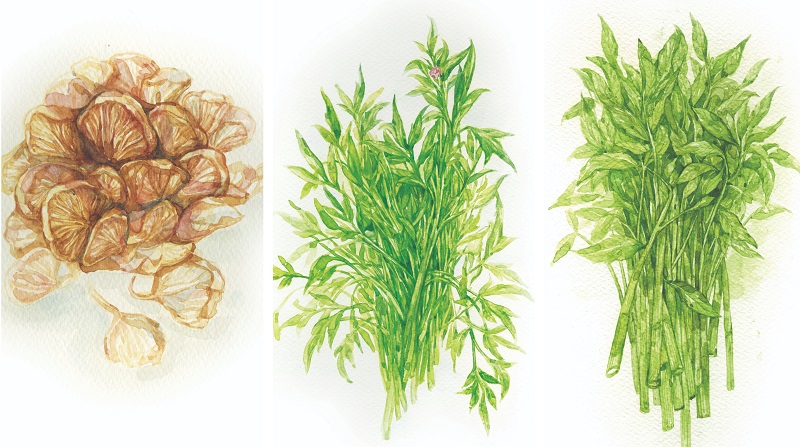
Cendawan kukur
With an appearance similar to tightly packed corals, this local mushroom has a spongey texture with a profound aromatic profile. Also known as “split gills” due to its shape, the mushroom is harvested in the wild on decaying trees after rainy periods.
Eat it at: DC Restaurant has crafted a platter of bite-sized mini tartlets for its seasonal summer menu, one of which features the cendawan kukur.
Ulam raja
Contrary to popular belief, the plant is not a native species despite being used so extensively in Malay cuisine — it originates from Latin America. Bearing purple or pink flowers, the “king’s salad” imparts the taste of a green mango when crushed.
Eat it at: Chocha Foodstore in Petaling Street has turned this salad staple into a velvety crème brûlée. Made from dehydrated ulam raja, the pool of cool, silky cream is sweetened with a crushing of honeycomb.
Daun selom
The water celery or water dropwort, which grows in the wild along streams and the edges of ponds, is relished as a favourite in kerabu.
Eat it at: The smattering of daun selom atop the sticky pork ribs at Table & Apron is more than just garnish; the leaves’ herbaceous aroma helps to cut through the richness of the meat.
This article first appeared on Aug 27, 2018 in The Edge Malaysia.


